A Hybrid Model to Assess the Remaining Useful Life of Proton Exchange Membrane Fuel Cells
Abstract
1. Introduction
2. Experimental Methods
3. Particle Filter
- (1)
- Prediction: The n particles are propagated from time k − 1 to k by the state equation, and then gain a new system distribution.
- (2)
- Update: The likelihood function of each particle is calculated based on the actual value, providing weight to each particle.
- (3)
- Re-sampling: A degeneracy phenomenon occurs with an increasing number of iterations, i.e., the number of particles with small weights tends to increase. Therefore, the particles with low weights are removed and particles with relatively large weights are copied via re-sampling. The recurrence formula of weight is:
4. Hybrid Prognostic Model
4.1. Prognostic Models for RUL
4.1.1. Voltage Model
- (1)
- The linear model:
- (2)
- The exponential model:
- (3)
- The logarithmic model:
- (1)
- The linear model:
- (2)
- The exponential model:
- (3)
- The logarithmic model:
4.1.2. Mechanism Model
4.2. Hybrid Diagnostic Approach
- The advantages of the voltage model are as follows—the voltage as a degradation index is easy to be measured; the degradation trend can be observed directly. While its disadvantages are—the fuel cell can be observed being degraded, but the degradation mechanism cannot be understood directly; the predicted RUL is sensitive to the local variation of the measured data, which many affect the prediction accuracy.
- For the mechanism model, though aging indices reflect the internal aging state of the FC, the data used by this model are obtained from the characterization and performance test after shutdown, which are complex and high-cost; therefore, related data are not abundant, with poor practicality.
5. Results and Discussion
5.1. Degradation Prediction Based on the Voltage Model
5.1.1. Voltage Aging Prediction
5.1.2. RUL Estimations
- (1)
- α metric is the allowable error bound around the actual RUL, which is taken as α = ±5% in this paper, meeting the prediction requirements of industrial applications [38]. If the prediction point stands in the interval of the accuracy zone, it is considered that the prediction result meets the accuracy requirements, which is an on-time prediction. There are two other cases: early predictions and late predictions. Early prediction means that the predicted RUL is smaller than the actual RUL and the point falls below the accuracy zone. Late prediction means that the predicted RUL is greater than the actual RUL and the point falls above the accuracy zone. The late prediction indicates that the prediction exceeds the actual value, which cannot warn users in time to make a decision for maintenance or adjust operating conditions. Therefore, on-time prediction and early prediction are more meaningful and desirable [2]. The number of prediction points in each region is denoted by N.
- (2)
- SH is defined as a duration when the prediction in the interval of allowable error range is around the actual RUL [2]. Herein, the SH can evaluate the prediction ability of the model, and a high SH value corresponds to a better prediction quality.
5.2. Degradation Prediction Based on the Mechanism Model
5.2.1. Voltage Aging Prediction
5.2.2. RUL Estimation
5.3. Comparison with the Hybrid Model
6. Conclusions
- (1)
- The overall trend of the performance degradation curve of the FC varies during different periods of the whole lifetime, which slightly increases from 0 to 5000 h and decreases at a small rate for a long time, followed by a rapid decline at the end of life. Therefore, the fuel cell performance degradation curve exhibits non-monotonic and non-linear characteristics which cannot be fitted only with a simple linear model.
- (2)
- The voltage model was developed based on the voltage data, which can be measured easily, and the prediction accuracy of linear, exponential and logarithmic models is compared. The results reveal that the logarithm model can assess the characteristics of rapid voltage decrease with a shorter TP than other models, and the stacked RMSE and MAPE are the lowest. The RUL prediction value is more stable, with an average dispersion of 56 h. The prediction performance of the voltage model improves with increasing training time. However, this model is sensitive to local and periodic changes in the voltage curve, which leads to a relatively large prediction error with a short TP.
- (3)
- The mechanism model was developed based on the evolution characteristics of degradation indices, which can reflect the degradation of FCs. It is found that the activation loss caused by the decrease in iloss and ECSA contributes most to the output voltage drop, and the degradation rate of the membrane and CL is higher than that of the GDL. The mechanism model is reliable and underestimates RUL, whereas the dispersion of prediction results is relatively large and it requires aging data from complex and high-cost characterization and performance tests, limiting practical applications.
- (4)
- The hybrid model combining the voltage and mechanism models is proposed to utilize the advantages of each model. The results reveal that when the TP is more than 4500 h, the errors of RUL prediction are less than 9.72%, 3.90% and 2.01% for the voltage, mechanism and hybrid model, respectively. The RUL prediction results of the hybrid model are close to the actual RUL when the prediction results of the voltage method are far from the accuracy zone. Hence, the proposed hybrid model provides credible RUL predictions with the highest accuracy.
Author Contributions
Funding
Institutional Review Board Statement
Informed Consent Statement
Data Availability Statement
Conflicts of Interest
References
- Liu, H.; Chen, J.; Hissel, D.; Lu, J.; Hou, M.; Shao, Z. Prognostics Methods and Degradation Indexes of Proton Exchange Membrane Fuel Cells: A Review. Renew. Sustain. Energy Rev. 2020, 123, 109721. [Google Scholar] [CrossRef]
- Hua, Z.; Zheng, Z.; Pahon, E.; Péra, M.-C.; Gao, F. A Review on Lifetime Prediction of Proton Exchange Membrane Fuel Cells System. J. Power Sources 2022, 529, 231256. [Google Scholar] [CrossRef]
- Zhao, M.; Shi, W.; Wu, B.; Liu, W.; Liu, J.; Xing, D.; Yao, Y.; Hou, Z.; Ming, P.; Zou, Z. Influence of Membrane Thickness on Membrane Degradation and Platinum Agglomeration under Long-Term Open Circuit Voltage Conditions. Electrochim. Acta 2015, 153, 254–262. [Google Scholar] [CrossRef]
- Chandesris, M.; Vincent, R.; Guetaz, L.; Roch, J.-S.; Thoby, D.; Quinaud, M. Membrane Degradation in PEM Fuel Cells: From Experimental Results to Semi-Empirical Degradation Laws. Int. J. Hydrogen Energy 2017, 42, 8139–8149. [Google Scholar] [CrossRef]
- Inaba, M.; Kinumoto, T.; Kiriake, M.; Umebayashi, R.; Tasaka, A.; Ogumi, Z. Gas Crossover and Membrane Degradation in Polymer Electrolyte Fuel Cells. Electrochim. Acta 2006, 51, 5746–5753. [Google Scholar] [CrossRef]
- Truc, N.T.; Ito, S.; Fushinobu, K. Numerical and Experimental Investigation on the Reactant Gas Crossover in a PEM Fuel Cell. Int. J. Heat Mass Transf. 2018, 127, 447–456. [Google Scholar] [CrossRef]
- Tang, Q.; Li, B.; Yang, D.; Ming, P.; Zhang, C.; Wang, Y. Review of Hydrogen Crossover through the Polymer Electrolyte Membrane. Int. J. Hydrogen Energy 2021, 46, 22040–22061. [Google Scholar] [CrossRef]
- Bi, W.; Fuller, T.F. Modeling of PEM Fuel Cell Pt/C Catalyst Degradation. J. Power Sources 2008, 178, 188–196. [Google Scholar] [CrossRef]
- Robin, C.; Gérard, M.; Quinaud, M.; d’Arbigny, J.; Bultel, Y. Proton Exchange Membrane Fuel Cell Model for Aging Predictions: Simulated Equivalent Active Surface Area Loss and Comparisons with Durability Tests. J. Power Sources 2016, 326, 417–427. [Google Scholar] [CrossRef]
- Ren, P.; Pei, P.; Li, Y.; Wu, Z.; Chen, D.; Huang, S. Degradation Mechanisms of Proton Exchange Membrane Fuel Cell under Typical Automotive Operating Conditions. Prog. Energy Combust. Sci. 2020, 80, 100859. [Google Scholar] [CrossRef]
- Reid, O.; Saleh, F.S.; Easton, E.B. Determining Electrochemically Active Surface Area in PEM Fuel Cell Electrodes with Electrochemical Impedance Spectroscopy and Its Application to Catalyst Durability. Electrochim. Acta 2013, 114, 278–284. [Google Scholar] [CrossRef]
- Polverino, P.; Pianese, C. Model-Based Prognostic Algorithm for Online RUL Estimation of PEMFCs. In Proceedings of the 2016 3rd Conference on Control and Fault-Tolerant Systems (SysTol), Barcelona, Spain, 7–9 September 2016; IEEE: Barcelona, Spain, 2016; pp. 599–604. [Google Scholar]
- Baik, K.D.; Kim, S.I.; Hong, B.K.; Han, K.; Kim, M.S. Effects of Gas Diffusion Layer Structure on the Open Circuit Voltage and Hydrogen Crossover of Polymer Electrolyte Membrane Fuel Cells. Int. J. Hydrogen Energy 2011, 36, 9916–9925. [Google Scholar] [CrossRef]
- Lapicque, F.; Belhadj, M.; Bonnet, C.; Pauchet, J.; Thomas, Y. A Critical Review on Gas Diffusion Micro and Macroporous Layers Degradations for Improved Membrane Fuel Cell Durability. J. Power Sources 2016, 336, 40–53. [Google Scholar] [CrossRef]
- Pan, Y.; Wang, H.; Brandon, N.P. Gas Diffusion Layer Degradation in Proton Exchange Membrane Fuel Cells: Mechanisms, Characterization Techniques and Modelling Approaches. J. Power Sources 2021, 513, 230560. [Google Scholar] [CrossRef]
- Zhang, L.; Liu, Y.; Song, H.; Wang, S.; Zhou, Y.; Hu, S.J. Estimation of Contact Resistance in Proton Exchange Membrane Fuel Cells. J. Power Sources 2006, 162, 1165–1171. [Google Scholar] [CrossRef]
- Lin, C.-H.; Tsai, S.-Y. An Investigation of Coated Aluminium Bipolar Plates for PEMFC. Appl. Energy 2012, 100, 87–92. [Google Scholar] [CrossRef]
- Orsi, A.; Kongstein, O.E.; Hamilton, P.J.; Oedegaard, A.; Svenum, I.H.; Cooke, K. An Investigation of the Typical Corrosion Parameters Used to Test Polymer Electrolyte Fuel Cell Bipolar Plate Coatings, with Titanium Nitride Coated Stainless Steel as a Case Study. J. Power Sources 2015, 285, 530–537. [Google Scholar] [CrossRef]
- Yang, L.X.; Liu, R.J.; Wang, Y.; Liu, H.J.; Zeng, C.L.; Fu, C. Corrosion and Interfacial Contact Resistance of Nanocrystalline β-Nb2N Coating on 430 FSS Bipolar Plates in the Simulated PEMFC Anode Environment. Int. J. Hydrogen Energy 2021, 46, 32206–32214. [Google Scholar] [CrossRef]
- Jouin, M.; Gouriveau, R.; Hissel, D.; Péra, M.-C.; Zerhouni, N. Prognostics of PEM Fuel Cell in a Particle Filtering Framework. Int. J. Hydrogen Energy 2014, 39, 481–494. [Google Scholar] [CrossRef]
- Lechartier, E.; Laffly, E.; Péra, M.-C.; Gouriveau, R.; Hissel, D.; Zerhouni, N. Proton Exchange Membrane Fuel Cell Behavioral Model Suitable for Prognostics. Int. J. Hydrogen Energy 2015, 40, 8384–8397. [Google Scholar] [CrossRef]
- Chen, H.; Zhan, Z.; Jiang, P.; Sun, Y.; Liao, L.; Wan, X.; Du, Q.; Chen, X.; Song, H.; Zhu, R.; et al. Whole Life Cycle Performance Degradation Test and RUL Prediction Research of Fuel Cell MEA. Appl. Energy 2022, 310, 118556. [Google Scholar] [CrossRef]
- Wu, Y.; Breaz, E.; Gao, F.; Paire, D.; Miraoui, A. Nonlinear Performance Degradation Prediction of Proton Exchange Membrane Fuel Cells Using Relevance Vector Machine. IEEE Trans. Energy Convers. 2016, 31, 1570–1582. [Google Scholar] [CrossRef]
- Ma, R.; Yang, T.; Breaz, E.; Li, Z.; Briois, P.; Gao, F. Data-Driven Proton Exchange Membrane Fuel Cell Degradation Predication through Deep Learning Method. Appl. Energy 2018, 231, 102–115. [Google Scholar] [CrossRef]
- Hua, Z.; Zheng, Z.; Pahon, E.; Péra, M.-C.; Gao, F. Remaining Useful Life Prediction of PEMFC Systems under Dynamic Operating Conditions. Energy Convers. Manag. 2021, 231, 113825. [Google Scholar] [CrossRef]
- Sankavaram, C.; Pattipati, B.; Kodali, A.; Pattipati, K.; Azam, M.; Kumar, S.; Pecht, M. Model-Based and Data-Driven Prognosis of Automotive and Electronic Systems. In Proceedings of the 2009 IEEE International Conference on Automation Science and Engineering, Bangalore, India, 22–25 August 2009; IEEE: Bangalore, India, 2009; pp. 96–101. [Google Scholar]
- Hu, Z.; Xu, L.; Li, J.; Ouyang, M.; Song, Z.; Huang, H. A Reconstructed Fuel Cell Life-Prediction Model for a Fuel Cell Hybrid City Bus. Energy Convers. Manag. 2018, 156, 723–732. [Google Scholar] [CrossRef]
- Xie, Y.; Zou, J.; Li, Z.; Gao, F.; Peng, C. A Novel Deep Belief Network and Extreme Learning Machine Based Performance Degradation Prediction Method for Proton Exchange Membrane Fuel Cell. IEEE Access 2020, 8, 176661–176675. [Google Scholar] [CrossRef]
- Ma, R.; Xie, R.; Xu, L.; Huangfu, Y.; Li, Y. A Hybrid Prognostic Method for PEMFC with Aging Parameter Prediction. IEEE Trans. Transp. Electrif. 2021, 7, 2318–2331. [Google Scholar] [CrossRef]
- Silva, R.E.; Gouriveau, R.; Jemeï, S.; Hissel, D.; Boulon, L.; Agbossou, K.; Yousfi Steiner, N. Proton Exchange Membrane Fuel Cell Degradation Prediction Based on Adaptive Neuro-Fuzzy Inference Systems. Int. J. Hydrogen Energy 2014, 39, 11128–11144. [Google Scholar] [CrossRef]
- He, L.; Zhan, Z.; Chen, H.; Jiang, P.; Yu, Y.; Yang, X.; Sun, Y.; Wan, X.; Liao, L.; Li, S.; et al. A Quick Evaluation Method for the Lifetime of the Fuel Cell MEA with the Particle Filter Algorithm. Int. J. Green Energy 2021, 18, 1536–1549. [Google Scholar] [CrossRef]
- Pei, P.; Chang, Q.; Tang, T. A Quick Evaluating Method for Automotive Fuel Cell Lifetime. Int. J. Hydrogen Energy 2008, 33, 3829–3836. [Google Scholar] [CrossRef]
- Fu, K.; Tian, T.; Chen, Y.; Li, S.; Cai, C.; Zhang, Y.; Guo, W.; Pan, M. The Durability Investigation of a 10-cell Metal Bipolar Plate Proton Exchange Membrane Fuel Cell Stack. Int. J. Energy Res. 2019, 43, 2605–2614. [Google Scholar] [CrossRef]
- Jouin, M.; Gouriveau, R.; Hissel, D.; Péra, M.-C.; Zerhouni, N. Degradations Analysis and Aging Modeling for Health Assessment and Prognostics of PEMFC. Reliab. Eng. Syst. Saf. 2016, 148, 78–95. [Google Scholar] [CrossRef]
- Jouin, M.; Gouriveau, R.; Hissel, D.; Pera, M.-C.; Zerhouni, N. Joint Particle Filters Prognostics for Proton Exchange Membrane Fuel Cell Power Prediction at Constant Current Solicitation. IEEE Trans. Reliab. 2016, 65, 336–349. [Google Scholar] [CrossRef]
- Chen, K.; Laghrouche, S.; Djerdir, A. Fuel Cell Health Prognosis Using Unscented Kalman Filter: Postal Fuel Cell Electric Vehicles Case Study. Int. J. Hydrogen Energy 2019, 44, 1930–1939. [Google Scholar] [CrossRef]
- Zhang, D.; Baraldi, P.; Cadet, C.; Yousfi-Steiner, N.; Bérenguer, C.; Zio, E. An Ensemble of Models for Integrating Dependent Sources of Information for the Prognosis of the Remaining Useful Life of Proton Exchange Membrane Fuel Cells. Mech. Syst. Signal Process. 2019, 124, 479–501. [Google Scholar] [CrossRef]
- Zhang, D.; Cadet, C.; Bérenguer, C.; Yousfi-Steiner, N. Some Improvements of Particle Filtering Based Prognosis for PEM Fuel Cells. IFAC-PapersOnLine 2016, 49, 162–167. [Google Scholar] [CrossRef]
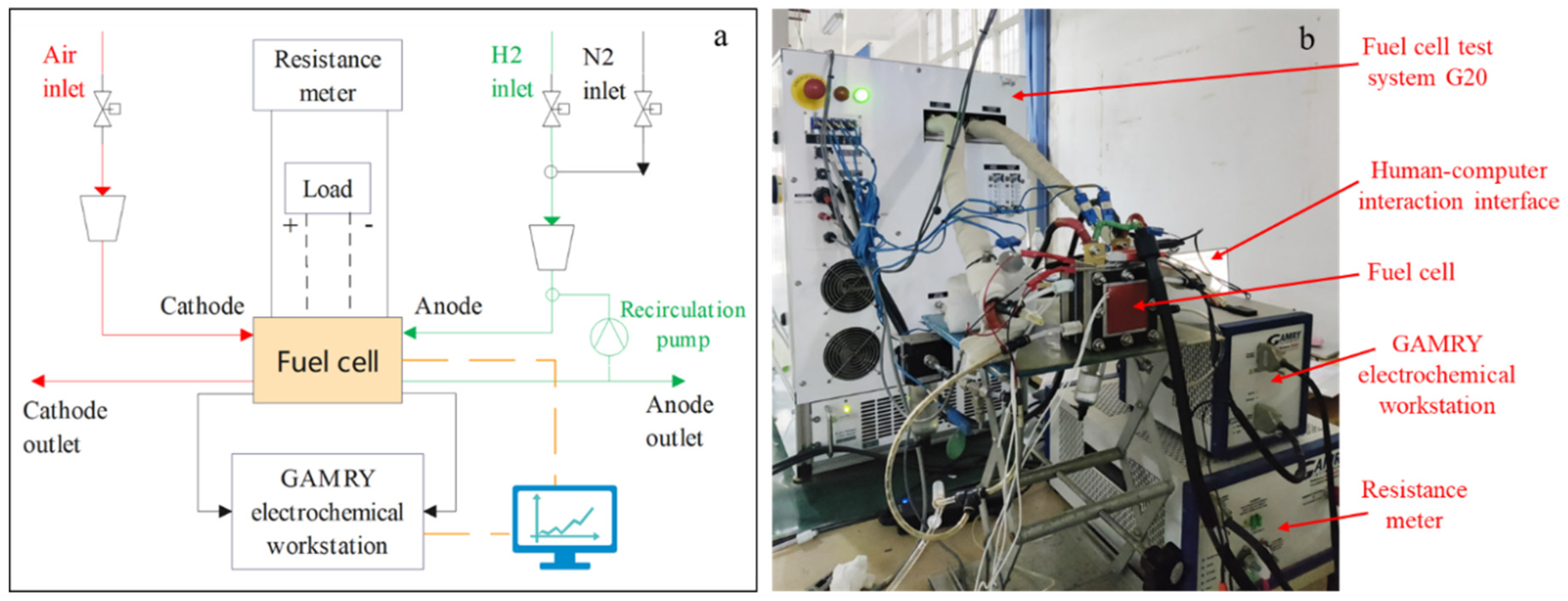



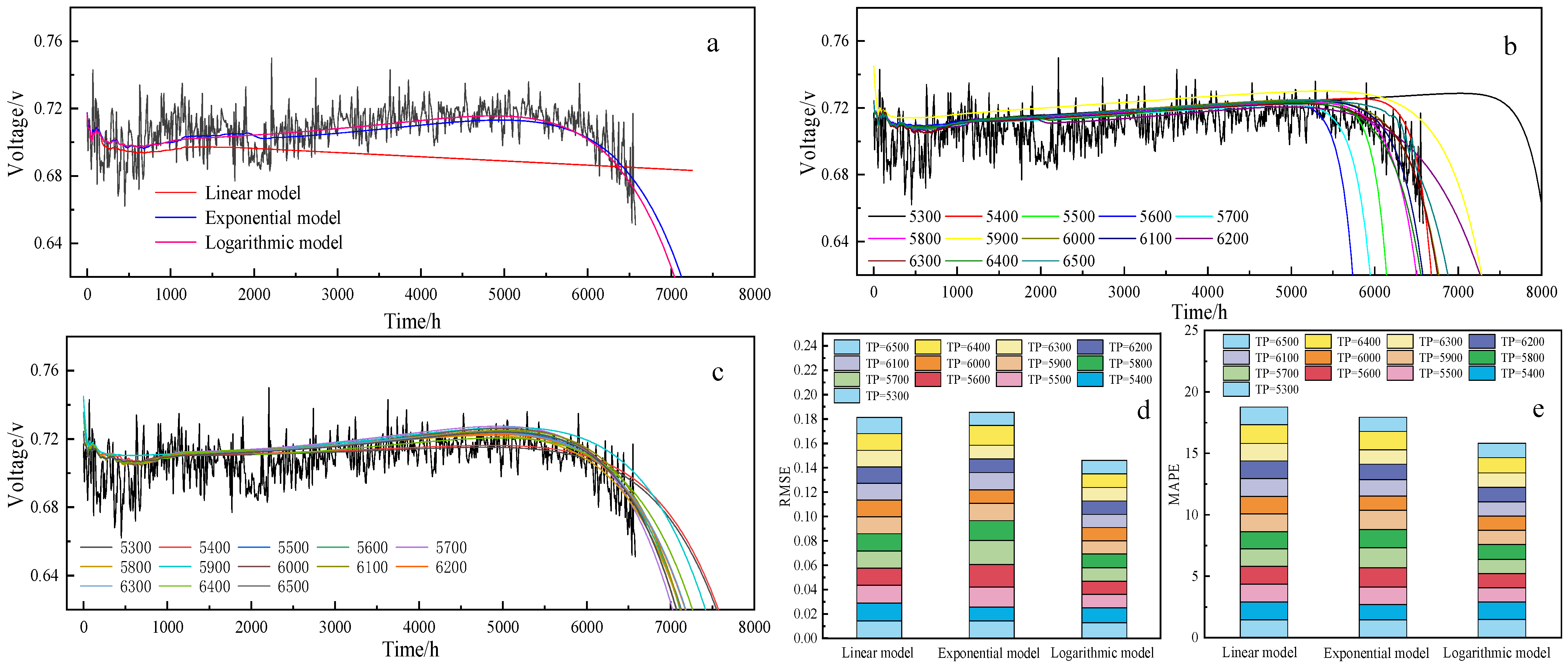
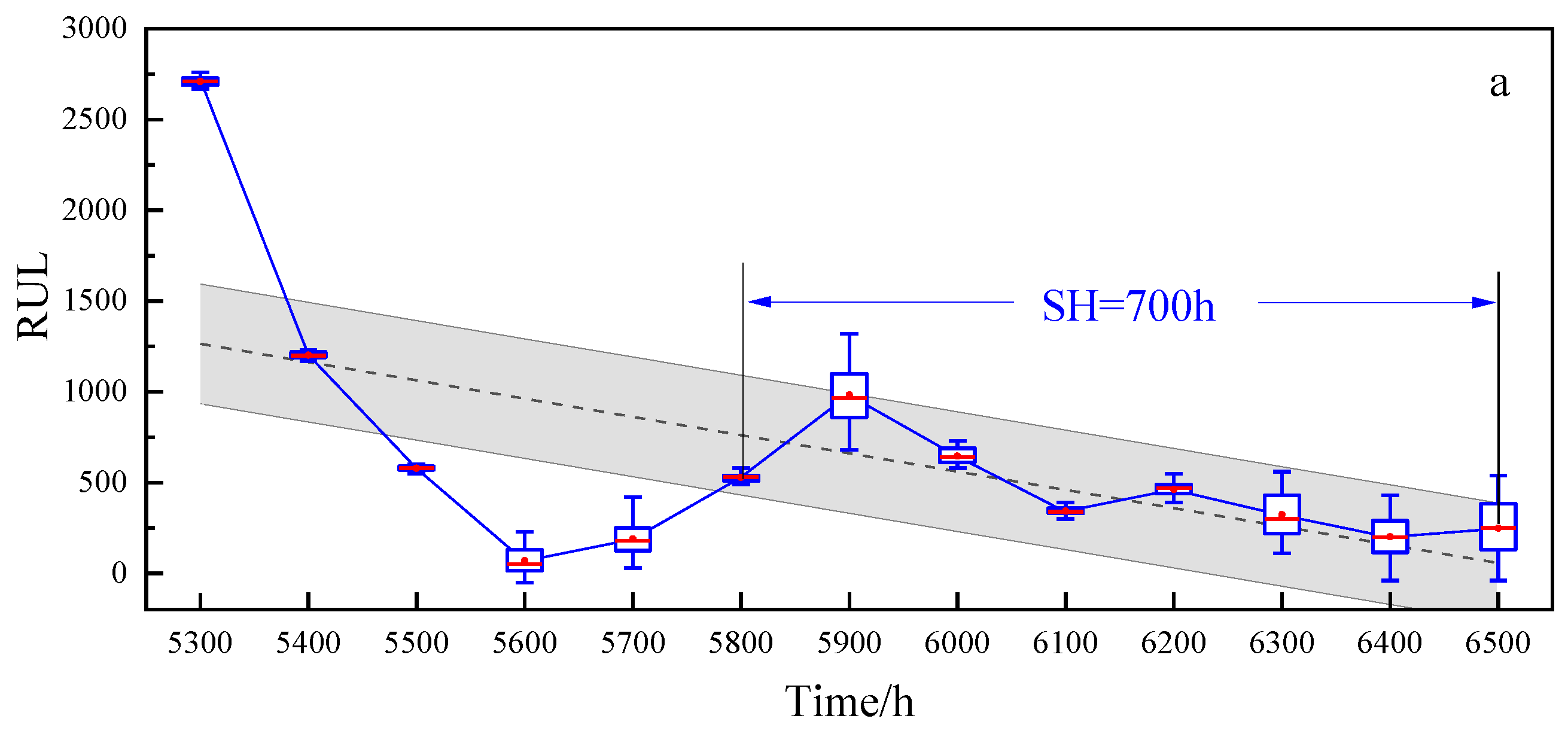
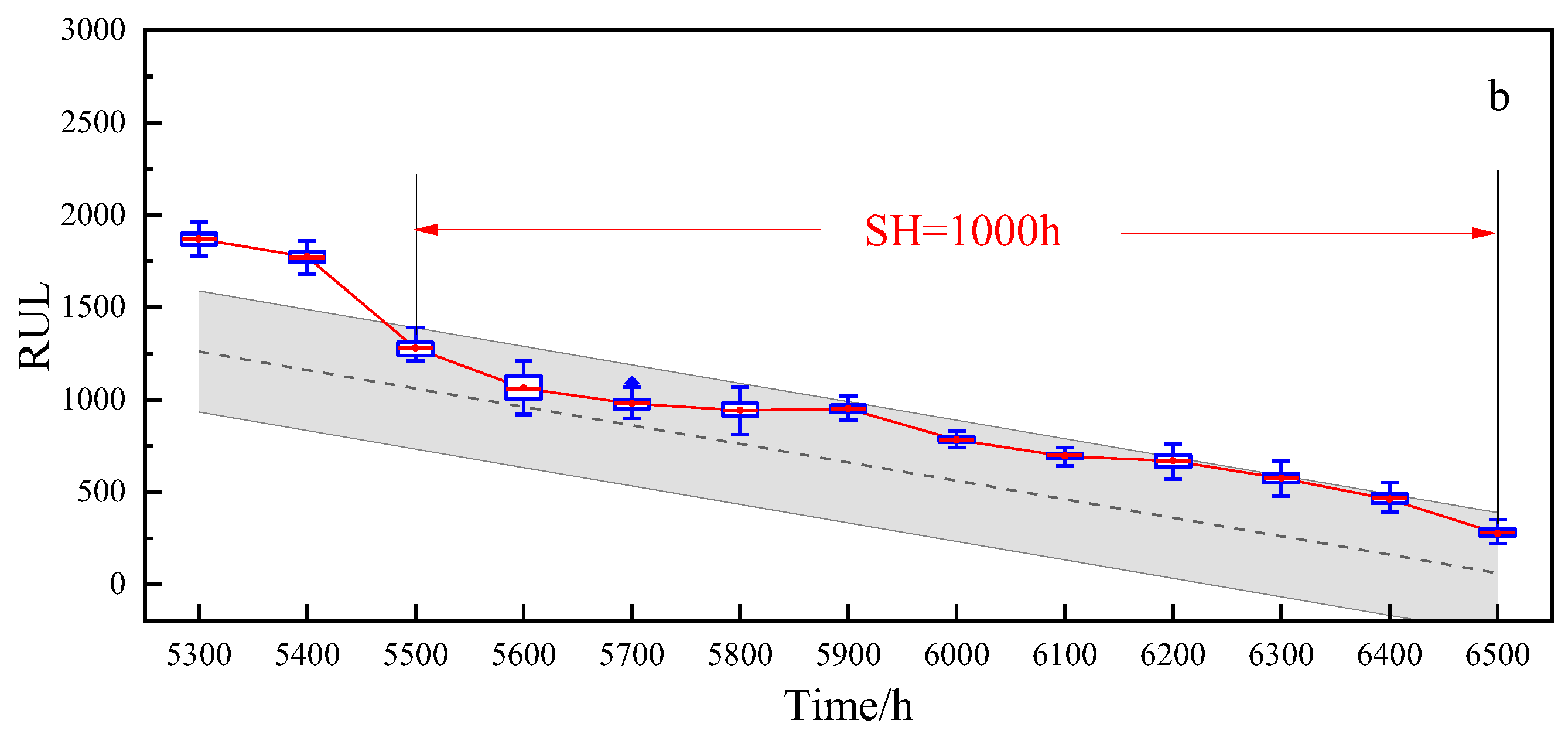
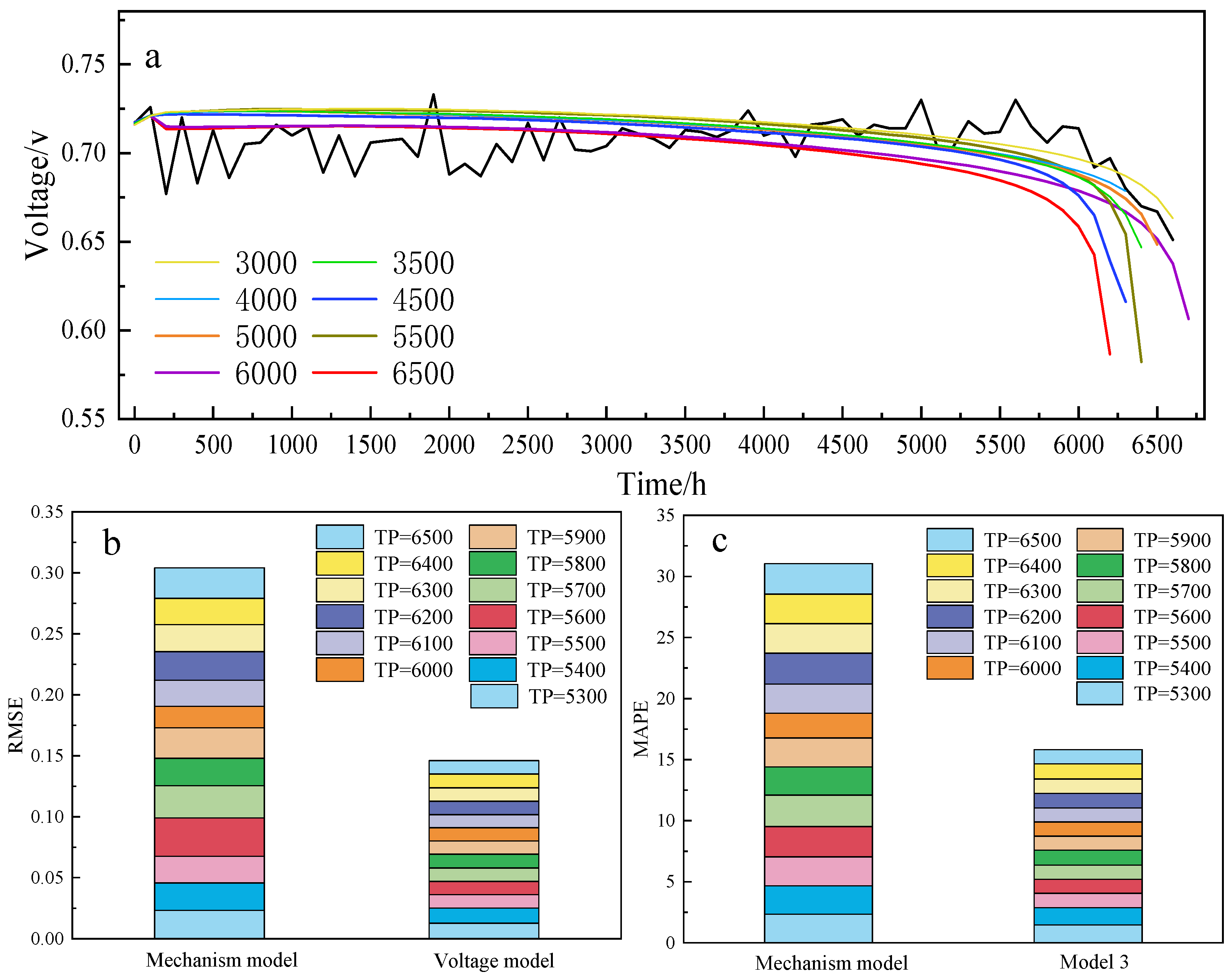
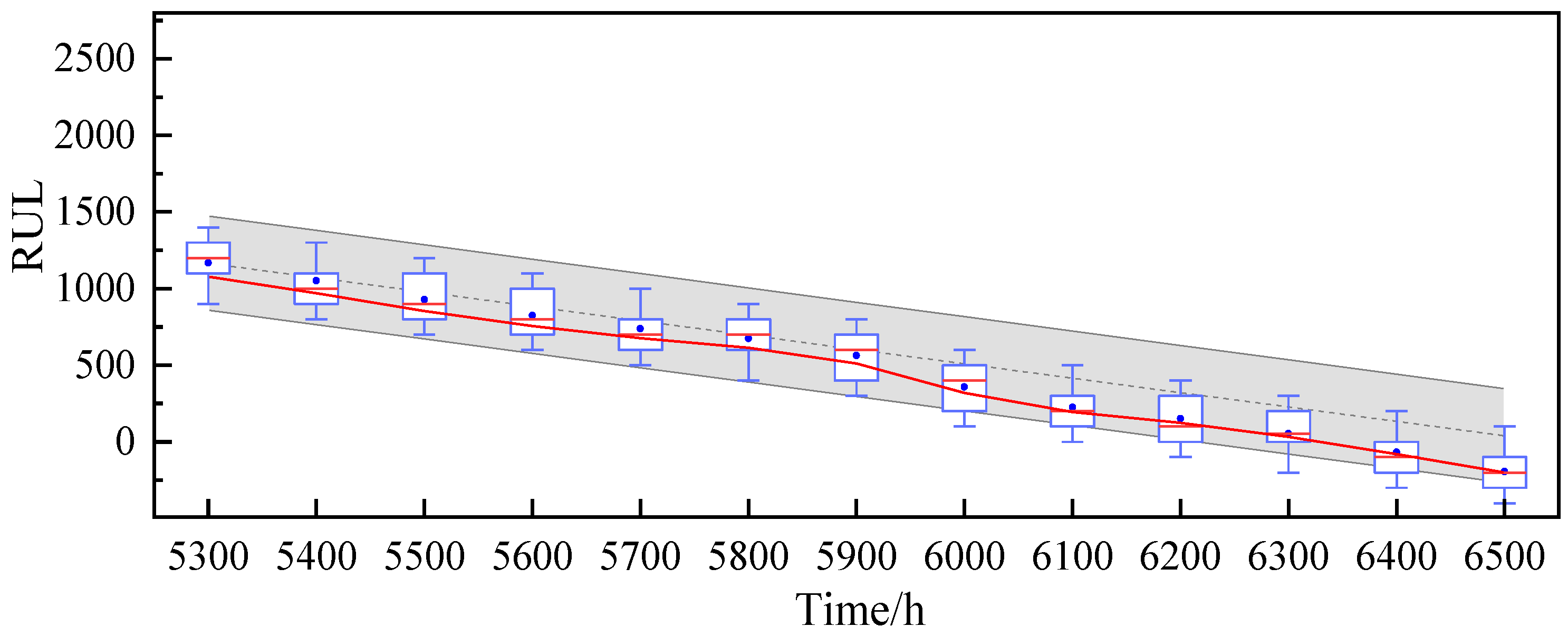


| Linear Model | Exponential Model | Logarithmic Model | ||||
|---|---|---|---|---|---|---|
| TP | RMSE | MAPE | RMSE | MAPE | RMSE | MAPE |
| 5300 | 0.01436 | 1.441 | 0.01431 | 1.446 | 0.01274 | 1.472 |
| 5400 | 0.01468 | 1.467 | 0.01147 | 1.239 | 0.01238 | 1.414 |
| 5500 | 0.01454 | 1.455 | 0.01622 | 1.429 | 0.01097 | 1.165 |
| 5600 | 0.01399 | 1.431 | 0.01871 | 1.582 | 0.01089 | 1.158 |
| 5700 | 0.01422 | 1.430 | 0.01951 | 1.634 | 0.01096 | 1.157 |
| 5800 | 0.01399 | 1.414 | 0.01628 | 1.470 | 0.01129 | 1.220 |
| 5900 | 0.01388 | 1.428 | 0.01422 | 1.561 | 0.01083 | 1.157 |
| 6000 | 0.01375 | 1.427 | 0.01112 | 1.159 | 0.01084 | 1.152 |
| 6100 | 0.01370 | 1.445 | 0.01412 | 1.343 | 0.01078 | 1.152 |
| 6200 | 0.01360 | 1.442 | 0.01133 | 1.247 | 0.01104 | 1.184 |
| 6300 | 0.01342 | 1.430 | 0.01115 | 1.176 | 0.01097 | 1.172 |
| 6400 | 0.01377 | 1.520 | 0.01614 | 1.491 | 0.01133 | 1.247 |
| 6500 | 0.01336 | 1.446 | 0.01094 | 1.168 | 0.01097 | 1.166 |
| N | Exponential | Logarithmic |
|---|---|---|
| Early prediction | 3 | 0 |
| On-time prediction | 8 | 11 |
| Late prediction | 2 | 2 |
| sum | 13 | 13 |
| Exponential | Logarithmic | |
|---|---|---|
| Minimum range | 20 | 30 |
| Average range | 106.5 | 56 |
| Maximum range | 252.5 | 122.5 |
| Time | Characteristic | iloss /A cm−2 | ECSA /m2 g−1 | HFR /mOhm cm−2 | ilim /A cm−2 | Output Voltage /V |
|---|---|---|---|---|---|---|
| T = 0 h | Value | 0.00304 | 21.952 | 1.851 | 2.248 | 0.718 |
| Voltage drop/V | 0.00011 | 0.401 | 0.033 | 0.036 | ||
| T = 2000 h | Value | 0.00332 | 9.837 | 1.757 | 2.695 | 0.699 |
| Voltage drop/V | 0.00012 | 0.421 | 0.0351 | 0.0333 | ||
| Relative change ratio | 0.092 | −0.552 | −0.051 | 0.199 | ||
| T = 5000 h | Value | 0.00449 | 12.928 | 1.716 | 2.643 | 0.708 |
| Voltage drop/V | 0.00017 | 0.412 | 0.0343 | 0.0341 | ||
| Relative change ratio | 0.477 | −0.411 | −0.073 | 0.176 | ||
| T = 6562 h | Value | 0.08100 | 6.352 | 1.741 | 1.886 | 0.663 |
| Voltage drop/V | 0.00289 | 0.433 | 0.0348 | 0.0544 | ||
| Relative change ratio | 25.645 | −0.711 | −0.059 | −0.161 |
| TP | RMSE | MAPE | TP | RMSE | MAPE |
|---|---|---|---|---|---|
| 5300 | 0.0232 | 2.349 | 6000 | 0.01760 | 2.021 |
| 5400 | 0.02248 | 2.313 | 6100 | 0.02141 | 2.394 |
| 5500 | 0.02189 | 2.372 | 6200 | 0.02349 | 2.524 |
| 5600 | 0.03144 | 2.492 | 6300 | 0.02210 | 2.410 |
| 5700 | 0.02636 | 2.562 | 6400 | 0.02163 | 2.428 |
| 5800 | 0.02257 | 2.318 | 6500 | 0.02499 | 2.493 |
| 5900 | 0.02496 | 2.371 |
| Voltage | Mechanism | |
|---|---|---|
| Minimum range | 30 | 200 |
| Average range | 56 | 257.1 |
| Maximum range | 122.5 | 300 |
Disclaimer/Publisher’s Note: The statements, opinions and data contained in all publications are solely those of the individual author(s) and contributor(s) and not of MDPI and/or the editor(s). MDPI and/or the editor(s) disclaim responsibility for any injury to people or property resulting from any ideas, methods, instructions or products referred to in the content. |
© 2023 by the authors. Licensee MDPI, Basel, Switzerland. This article is an open access article distributed under the terms and conditions of the Creative Commons Attribution (CC BY) license (https://creativecommons.org/licenses/by/4.0/).
Share and Cite
Du, Q.; Zhan, Z.; Wen, X.; Zhang, H.; Tan, Y.; Li, S.; Pan, M. A Hybrid Model to Assess the Remaining Useful Life of Proton Exchange Membrane Fuel Cells. Processes 2023, 11, 1583. https://doi.org/10.3390/pr11051583
Du Q, Zhan Z, Wen X, Zhang H, Tan Y, Li S, Pan M. A Hybrid Model to Assess the Remaining Useful Life of Proton Exchange Membrane Fuel Cells. Processes. 2023; 11(5):1583. https://doi.org/10.3390/pr11051583
Chicago/Turabian StyleDu, Qing, Zhigang Zhan, Xiaofei Wen, Heng Zhang, Yaowen Tan, Shang Li, and Mu Pan. 2023. "A Hybrid Model to Assess the Remaining Useful Life of Proton Exchange Membrane Fuel Cells" Processes 11, no. 5: 1583. https://doi.org/10.3390/pr11051583
APA StyleDu, Q., Zhan, Z., Wen, X., Zhang, H., Tan, Y., Li, S., & Pan, M. (2023). A Hybrid Model to Assess the Remaining Useful Life of Proton Exchange Membrane Fuel Cells. Processes, 11(5), 1583. https://doi.org/10.3390/pr11051583






